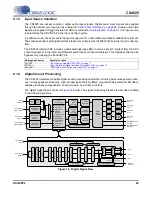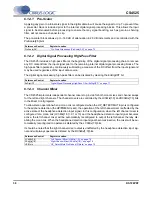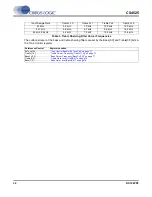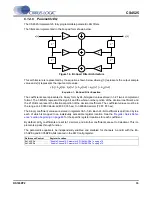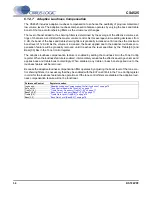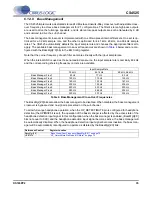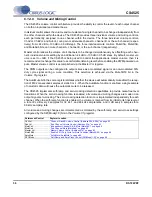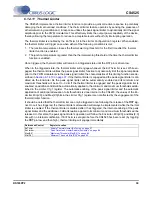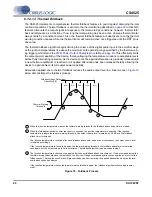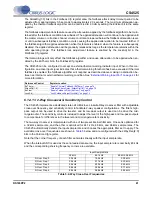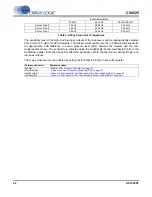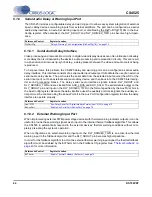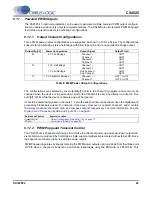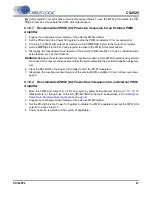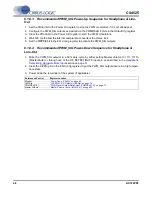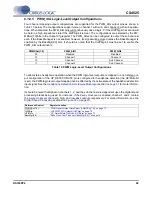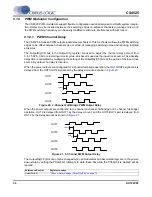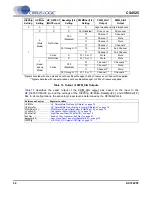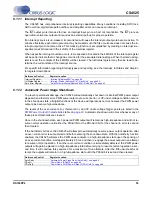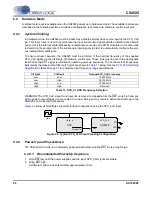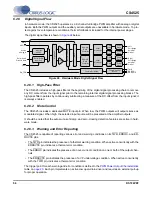
DS726PP2
41
CS4525
The AttackDly[1:0] bits in the Foldback Cfg register allow the foldback attack delay timeout period to be
adjusted from approximately 0.5 seconds to approximately 2.0 seconds. The maximum attenuation ap-
plied by the thermal foldback algorithm can be restricted to -30 dB by setting the EnFloor bit in the same
register.
The foldback adjustment lock feature causes the attenuation applied by the foldback algorithm to be main-
tained after the foldback condition has subsided. The applied attenuation will continue to be applied until
the master volume or all active channel volume controls are lowered below the foldback attenuation level,
or until a subsequent foldback condition occurs causing the applied attenuation to be lowered further. If
the foldback algorithm applies attenuation while this feature is enabled, when the feature is subsequently
disabled, the applied attenuation will be gradually released as long as the temperature remains within the
safe operating range. This foldback lock adjustment feature is enabled by the LockAdj bit in the
Foldback Cfg register.
Thermal warnings will only affect the foldback algorithm and cause attenuation to be applied when en-
abled by the EnTherm bit in the Foldback Cfg register.
The CS4525 can be configured to accept an external thermal warning indicator input. When in this con-
figuration, an active input signal indicates that a thermal warning threshold has been exceeded. If thermal
foldback is enabled, the foldback algorithm will respond as described above making no distinction be-
tween an internal or external thermal warning condition. See
“External Warning Input Port” on page 44
more information.
6.1.4.13 2-Way Crossover & Sensitivity Control
The CS4525 implements a dedicated stereo 24 dB/octave Linkwitz-Riley crossover filter with adjustable
cross-over frequency and sensitivity control to facilitate 2-way speaker configurations. The filter’s high-
pass output can be used to drive the tweeter, and its low-pass output is used can be drive the mid-
range/woofer. The sensitivity control is included to adjust the level of the high-pass and low-pass outputs
to compensate for differences in the tweeter and mid-range/woofer sensitivity.
The two-way crossover is implemented with one of two preset internal filter sets. One set is optimized for
a 32 kHz sample rate, and the other is optimized for 44.1 kHz, 48 kHz, and 96 kHz sample rates. The
CS4525 automatically detects the input sample rate and chooses the appropriate filter set to apply. The
available cross-over frequencies are shown in
below and are configured with the 2WayFreq[2:0]
bits in the Volume Cfg register.
Note that the corner frequency of each filter set scales linearly with the input sample rate.
When the internal ADC is used as the serial audio data source, the input sample rate is nominally 48 kHz
and the corresponding shelving frequency corners are available.
Referenced Control
Register Location
EnTherm .............................
“Enable Thermal Foldback (EnTherm)” on page 74
AttackDly[1:0] ......................
“Foldback Attack Delay (AttackDly[1:0])” on page 75
EnFloor................................
“Enable Foldback Floor (EnFloor)” on page 75
LockAdj ...............................
“Lock Foldback Adjust (LockAdj)” on page 74
Input Sample Rate
32 kHz
44.1 kHz
48 kHz, 96 kHz
X-Over Freq 0
2.0 kHz
1.92 kHz
2.09 kHz
X-Over Freq 1
2.2 kHz
2.11 kHz
2.30 kHz
X-Over Freq 2
2.4 kHz
2.30 kHz
2.50 kHz
X-Over Freq 3
2.6 kHz
2.49 kHz
2.71 kHz
X-Over Freq 4
2.8 kHz
2.68 kHz
2.92 kHz
Table 5. 2-Way Cross-Over Frequencies



